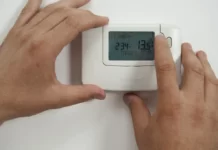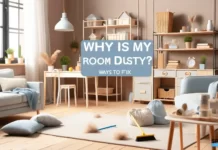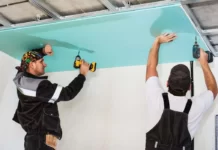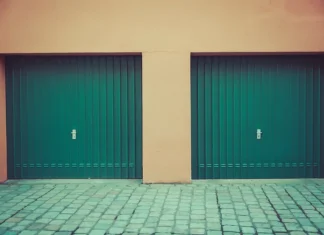Introduction to Temporary Wall
Temporary walls offer a versatile solution for dividing rooms, allowing you to form separate functional areas within your home space area. Whether you’re in need of a home office, accommodating a new family member, or simply looking for a fresh layout, building a temporary wall can be the best solution for you. We will take you through each step of constructing a temporary wall to effectively divide a room, providing both functionality and aesthetic appeal, but first, let us figure out what is meant by a temporary wall.
What is a Temporary wall?
A temporary wall, also known as a partition wall or room divider, is a non-permanent structure within any roomy space to create separate areas or rooms.
• Unlike traditional walls, temporary walls are not built into the structure of the building and can be easily removed or changed without causing damage to the existing space.
• Temporary walls are popular in urban areas where space is limited, and flexibility in room layout is essential.
• They can be made from various materials, including plywood, MDF (medium-density fiberboard), or even modular systems designed for easy assembly and disassembly.
What is Needed Before Constructing Your Temporary Wall?
Before making the decision to divide a room with a temporary wall, you have to address many points:
1. Assess Your Space and Know Your Needs
Before you start building a temporary wall, it’s important to evaluate your space and understand your needs and requirements:
- 1.1 Room Dimensions and Layout: At first, measure your room’s length, width, and height. Take note of any architectural features like windows, doors, and electrical outlets.
- 1.2 Put in Mind The Purpose of Division: Determine the main function of the divided spaces. Are you creating a home office, a private sleeping area, or a designated play space?
- 1.3 Design The Best Traffic Flow: Imagine how you will move through the divided spaces. Make sure that there is an access to and from each area.
- 1.4 Source of Natural Light and Ventilation: Take into your account how the temporary wall may affect the room’s natural light and airflow. Make appropriate adjustments if necessary to maintain natural sources as much as you can.
2. Decide What Are The Needed Materials and Tools For Your Temporary Wall
To construct a well-made and consistent temporary wall in your room, gather the following materials and tools, but firstly, know the available budget:
• 2.1 Materials:
o Plywood or MDF sheets (for wall panels)
o 2×4 lumber (for framing)
o Screws, nails, and anchors
o Paint or finish for surface treatment
• 2.2 Tools:
o Measuring tape and level
o Circular saw or hand saw
o Power drill and screwdriver bits
o Hammer and nails
3. Construct the Frame
Building a solid frame is the foundation of your temporary wall:
- 3.1 Top and Bottom Plates: Cut the 2×4 lumber to the length of the wall. These will serve as the top and bottom plates.
- 3.2 Vertical Studs: Space the vertical studs evenly along the length of the plates. Classically, studs are spaced 16 inches apart, center to center.
- 3.3 Securing the Frame: Attach the vertical studs to the plates using screws or nails. Ensure the frame is square and level.
4. Create Stability and Support
Stability is an important element for safe and durable temporary walls:
- 4.1 Horizontal Braces: Install horizontal braces between the vertical studs. These provide additional support and prevent the wall from bowing or shifting.
- 4.2 Reinforcing Corners: Use corner braces or additional framing to strengthen the corners of the temporary wall, guaranteeing maximum stability.
5. Finally, Secure the Temporary Wall in Place
Accurately fix the temporary wall and ensure it remains in place:
- 5.1 Ceiling Attachment: Use anchors or brackets to secure the top plate to the ceiling joists. Ensure it is firmly anchored to prevent any movement.
- 5.2 Floor Attachment: Attach the bottom plate to the floor using anchors or brackets. This adds additional firmness and prevents any potential swaying.
6. Add Your Final Finishing Touches
Complete your temporary wall and finalize it with a polished look:
- Surface Treatment: Sand all rough edges and apply the paint that complements the room’s overall decor. This step adds a final touch of refinement.
7. Optional Add-ons for Functionality
Enhance the functionality of your temporary wall with creative additions:
Add Shelves or Cubbies: Add shelves or cubbies into your final design. These provide convenient storage options and maximize the wall’s utility.
Design a Fold-Down Desk or Work Surface: Attach a fold-down desk to the temporary wall to create an instant workspace. The best of this design is that when not in use, it can be easily folded up to save space.
Use Hooks or Pegs: Attach hooks or pegs to the temporary wall to hang items like bags, coats, or accessories. This keeps the floor area clear and organized.
Corkboard or Whiteboard Panels: Apply corkboard or whiteboard panels to one side of the temporary wall. This provides a designated space for notes, reminders, and creative expression.
Use Bulletin Board or Pinboard: Install a bulletin board or pinboard on the temporary wall. This will help you display important documents, photos, or artwork.
Buy Some Trendy Mirrors: Fasten a mirror to the temporary wall to create a functional dressing area or to intensify natural light sources in your new room.
Apply Chalkboard Paint or Magnetic Paint: Apply chalkboard or magnetic paint to one side of the temporary wall. This turns it into a versatile surface for writing, drawing, or displaying magnetic items.
Buy Trendy Curtains or Fabric Panels: Hang curtains or fabric panels from the temporary wall to add privacy or conceal storage space behind it.
Always Use Sliding or Folding Doors: Attach sliding or folding doors to the temporary wall for added privacy or to create concealed storage areas.
Add Some Speaker Mounts or Soundproofing Panels: Install speaker mounts or soundproofing panels on the temporary wall to improve the audio quality in the divided spaces.
Install Charging Stations or Outlets: Add electrical outlets or charging stations to the temporary wall to provide convenient access to power sources for devices and appliances.
Art Display Rails: Install art display rails on the temporary wall to easily hang and change out artwork or decorations.












